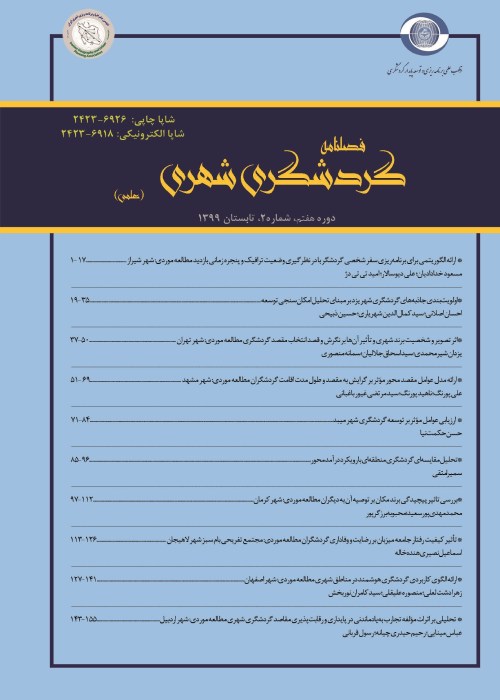Identifying the Tourism Industry Key Forces based on Strategic Scenario Planning(Case Study: Mako Free Zone)
The increase in future studies in tourism can be found in the fact that future discussions help government and private organizations in the field of tourism to clarify the future and make the right decisions. Among the various methods of future studies, scenario planning is considered a method along with measuring the amount of risk and creativity. Decision-makers and experts in the tourism industry in a world full of change and transformation need to develop new approaches, predict, and prepare for the future. Future studies in the field of tourism helps organizations and institutions related to tourism make the right decisions by providing data such as the amount of risk, success, and required capital. On the other hand, in order to increase competitiveness and create a relative advantage in the tourism industry, there is no other choice but to predict the future. The most obvious starting point would be to consider the types of visitor markets they are looking to develop. This research aims to answer the following goals by identifying the driving forces affecting the prosperity of the tourism industry in the Mako free zone while recognizing the capacities of regional development:• Discovery and identification of vital drivers affecting the tourism status of Mako free zone;Developing optimal scenarios and strategies for the economic prosperity of the tourism sector.
Considering the nature of the data and the impossibility of controlling the behavior of the effective variables in the problem, the current research is non-experimental. In this research, the cross effects matrix method from positivism, the Delphi technique from positivism, and the integration of quantitative and qualitative analysis resulting from the collaborative method have been used. In the first part, to rank and extract the impact matrix of the factors identified in the research on each other, Micmac and Scenario Wizard software have been exerted. The believable states, the separation of scenarios, and the spectrum of optimal triangles to the crisis in the tourism industry's prosperity have been identified with a foresight approach. It was also used to identify possible states from among the believable futures through scoring based on the Likert scale. By identifying external factors using PESTLE analysis in the Meta-SWOT software environment, opportunities and threats were grouped in economic, social, political, technological, legal, and environmental dimensions. In the final part, using the results of the environmental assessment and knowledge of the current situation, possible scenarios were presented. The best scenarios were selected to achieve the defined goals by testing these scenarios.
According to the impact matrix and potential direct and indirect dependence, it can be said that three drivers of commercialization policy and removal of economic, administrative, and political obstacles (HP1), security and political stability (GJ1), and marketing, identification and advertising (SP6) and government investment (GI5) are in the first rank of direct and indirect influence. And three drivers of production technology (L5), tax rate, cost, price level (L6), and domestic economic fluctuations (T1), are ranked first in direct and indirect impressionability. The grouping of scenarios shows that the scenarios of the first group include desirable conditions with approaches based on competitiveness, investor support, and sanctions adjustment, which include the best and most desirable possible conditions for the improvement and prosperity of tourism. In the scenarios of the second group, the differentiating factors are the difference in the amount of desirable and static states and crises. In terms of frequency, this group has the highest number of static situations among other scenarios. The scenarios of the third group are critical and unfavorable conditions, the impossibility of tourism development. This group of scenarios includes the crisis and the 12th and 13th scenarios. In terms of frequency, this group has the highest number of crises among other scenarios, so 0% of desirable situations, 13% of static situations, and 87% of crises. Among the factors affecting the tourism industry, five high-level priorities with the greatest weight were extracted; that the first factor in this process is security and political stability and commercialization policy strategies and removal of economic, administrative, and political barriers, sectoral and cross-sectoral participation, and cooperation, decision-making process, and stakeholder participation; Along with these macro factors, trends with negative effects such as the quality of tourism business systems, media and advertising, the effect of climate change and the reduction of biological resources, economic fluctuations and trade barriers are significant.
The creation of free zones is one of the most important means of economic development, which, if successful, has been associated with significant achievements for developing countries in particular. According to the strategic map, the three principles of resources and capabilities (macro trends), effective external factors, their proximity to each other, as well as the size of the bubbles, and their coordinates or weight were analyzed. And it was found that among the factors affecting the tourism industry, five high-level priorities with the most significant weight were extracted; which include security and political stability and commercialization policy strategies and removal of economic, administrative, and political barriers, sectoral and cross-sectoral participation, and cooperation, decision-making process and stakeholder participation. Along with these macro factors, trends with negative effects such as the quality of tourism business systems, media, and advertising, climate change and the reduction of biological resources, economic fluctuations, and trade barriers are significant.
- حق عضویت دریافتی صرف حمایت از نشریات عضو و نگهداری، تکمیل و توسعه مگیران میشود.
- پرداخت حق اشتراک و دانلود مقالات اجازه بازنشر آن در سایر رسانههای چاپی و دیجیتال را به کاربر نمیدهد.


